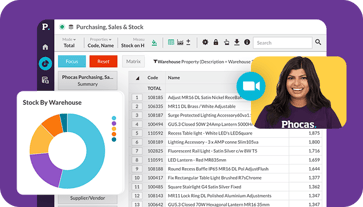Customer segmentation for wholesalers that your customers will appreciate
Most wholesale companies have access to sales data. Chances are you review sales weekly by variables like sales rep or product class. To make your sales efforts more effective, start by refining how you segment or group customers.
Many data segmentation methods exist (such as value-based or needs-based segmentation), but the Recency Frequency Monetary (RFM) model stands out. It’s a simple yet effective approach widely endorsed by academics.
The RFM model segments customers based on three factors using recency (how recently they purchased), frequency (how often they buy) and monetary value (how much they spend).
It categorizes wholesale customers into distinct groups based on your data. You can assign names to each group yourself from ‘Champions” at the top to those ‘Hibernating’ at the bottom or use default classifications.
But it is important to note that segmentation isn't about putting customers in boxes. It's about responding to customer needs and allowing sales reps to know exactly who to talk to, when and why. Segmentation adds nuance to your approach and moves you beyond generic sales strategies.
Segmentation helps you understand your diverse customer base
Think about your customer base. It’s a sum of many parts. Each customer, whether a long-standing partner or a first-time buyer, has their own needs, motivations and purchasing patterns. Relying solely on broad demographic data or experience can only take you so far. To sell really well, you need to understand the subtle cues in customer behavior and anticipate their needs. This is where a proven segmentation strategy sets you apart.
Without segmentation your team could be spending too much time on poor-fit prospects or neglecting your high-value clients. Chances are your messaging is generic and you’re missing pain points that people want to fix with your products. Effective customer segmentation provides the valuable insights needed to tailor your sales pitches and marketing efforts.
How to get ready to put a RFM model to work
Your sales team plays a critical role in implementing the RFM segmentation model. While the software will handle the heavy lifting of categorizing customers once it's set up, the accuracy comes from your initial input and understanding of your specific business situation. This preparation ensures your segments are both meaningful and actionable.
The first step is defining what recency means for a wholesale business. Define a realistic range for recency based on your typical sales patterns. For example, if you are a building supply distributor, an order placed last week is highly recent. An order from three months ago might still be considered reasonably recent if the customers order in bulk for specific projects with longer timelines. However, if six months have passed that customer might slip away. The sales team needs to come together and analyze typical sales cycles and customer behavior. How often do the active customers typically order? What's a normal gap between purchases for different types of clients? Defining these recency ranges based on your real-world experience will strengthen the ‘R’ score significantly.
You then need to apply similar thinking to the frequency and monetary values. For frequency, how many orders within a defined period (usually the last 6 or 12 months) is a frequent buyer versus an occasional one? For a building supplier, a customer making small orders weekly for a range of supplies might be as frequent in their own way as a larger builder placing substantial monthly orders. It's about defining what frequent engagement looks like for your business. You need to also set monetary value thresholds. Considering the range of your wholesale customer profiles from smaller businesses to larger enterprises will help you set realistic monetary segments. Thoughtfully defining these R, F, and M ranges ensures your segmentation aligns with your market and customer base. This initial groundwork that taps into your sales knowledge of customer’s purchase history will help the RFM model deliver valuable segments.
The RFM model uses your defined ranges and recent purchase history to categorize each wholesale customer into one of five segments from Champions to Hibernating.
This functionality allows you to see at a glance which customer segments require different approaches. Software that can run the RFM model dynamically groups customers by actual purchasing behavior and offers predictive insight into their future potential.
How RFM transforms your sales approach
Let’s explore how the RFM segments make your life easier and more productive. We'll break it down into five groups to help you know who to talk to and prioritize.
Let’s look at these five groups.
-
Champion. Your best customers. They buy recently, frequently and high spenders.
-
Promising. Nurture these relationships. Show them you understand their needs and can deliver value.
-
At risk. These customers need attention. Find out why their activity dropped and how to help.
-
Can't lose. These customers buy large quantity of products but infrequently. Focus on retention.
-
Hibernating. Low spenders with long gaps between purchases. Re-engagement campaigns may reignite interest.
Know what to say to each segment
Segmentation enables highly personalized communication and in an e-commerce environment, where there’s no salesperson at the counter, a friendly and relevant email makes all the difference.
For champions, your message might be about new premium offerings or loyalty rewards. For customers at risk, it could be an empathetic ‘we've missed you’ message with a compelling reason to return. This targeted approach makes your communication far more relevant and effective.
By understanding which segment customers fall into, you can infer their likely needs. The can't lose customers might be interested in product updates before they usually buy. This helps you create a better customer experience. Insights from these segments can inform specific marketing campaigns. Perhaps a particular segment responds well to volume discounts while another values premium service. This data can help refine pricing strategies for different segments.
By identifying high-value segments like champions and can’t lose, the entire sales team can focus efforts where the potential for profit is greatest. This also helps in identifying potential customers who share common characteristics with your top tiers.
The RFM model helps you refine your customer data you already you in Phocas. It uses existing purchase history to provide valuable insights that empower your dedicated sales reps to be more relevant. For B2B customers, RFM analysis can be incredibly powerful. When combined with firmographic data (like company size, industry and location) it offers an even more granular view, helping refine target markets. This is a foundational step towards a more sophisticated customer segmentation strategy.
Once you have implemented the RFM model get the sales team together to discuss how you can work through your approaches for each customer segment.
Embracing customer segmentation is about satisfying your customers and increasing sales. There is nothing more rewarding than building meaningful relationships with your wholesale customers by understanding their unique needs and tailoring your interactions accordingly.


Katrina is a professional writer with a decade of experience in business and tech. She explains how data can work for business people and finance teams without all the tech jargon.
Related blog posts

Manufacturers, distributors and retailers rely heavily on their suppliers to deliver quality products on time and at the right price. Strong supplier relationship management (SRM) is essential for these industries because it enables you and your suppliers to map out the supply chain, achieve economies of scale and offer customers an extensive choice of products.
Read more
DIFOT (Delivered In-Full, On-Time) or OTIF (On-Time In-Full) is a fundamental KPI when analyzing the performance of your supply chain. The main goal is to get your customers the products they need, when they need them, in the quantity they ordered. DIFOT measures how successful your business is at achieving this objective and identifies procurement problems and supplier reliability.
Read more
The U.S. wholesale distribution sector is experiencing a rapid acceleration in mergers & acquisitions (M&A) activity. From HVAC buying groups like Johnstone Supply acquiring independents, to family-owned distributors selling due to succession challenges, consolidation is reshaping the distribution landscape. One recent example is Hein Electric Supply's acquisition of Laser Electric Supply highlights how strategic buyers are capitalizing on opportunities across the middle market.
Read more
The Spring 2025 Fortune/Deloitte CEO Survey presents a consistent story of boardrooms experiencing a sense of cautious optimism controlled by an emphasis on fiscal responsibility. This is playing out with 42% of CEOs saying they want their teams to focus on cost-cutting measures without raising prices to avoid losing their customers.
Read moreBrowse by category

Find out how our platform gives you the visibility you need to get more done.
Get your demo today